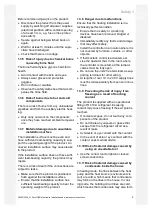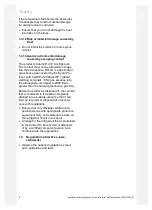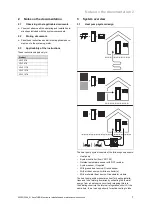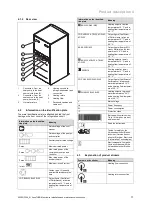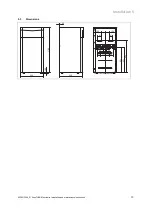
System overview 3
0020213394_01 flexoTHERM exclusive Installation and maintenance instructions
9
As thermal energy can only pass from a body at a higher
temperature to a body at a lower temperature, the coolant in
the evaporator must have a lower temperature than the heat
source. On the other hand, the temperature of the coolant in
the condenser must be higher than that of the heating water
in order to be able to release the thermal energy to it.
These different temperatures are produced in the coolant
circuit by means of a compressor and an expansion valve,
which are located between the evaporator and condenser.
The coolant flows in vapour form from the evaporator into the
compressor, where it is compressed. This causes the pres-
sure and temperature of the coolant vapour to rise sharply.
After this process, it flows through the condenser, where it
releases its thermal energy to the heating water by condens-
ation. It flows as a liquid into the expansion valve, where
it expands significantly and, in so doing, loses much of its
pressure and temperature. This temperature is now lower
than that of the brine that flows through the evaporator. The
coolant can thus absorb more thermal energy in the evap-
orator, turning into vapour in the process and flowing to the
compressor. The cycle starts again.
The evaporator and parts of the refrigerant circuit inside the
heat pump are cold-insulated, meaning that no condensate
can accumulate. Any small amounts of condensate which
may form evaporate as a result of the heat generated inside
the heat pump.
The product is equipped with an active cooling function that
you can use to maintain the temperature of your living rooms
when the outside temperature is high during summer. Air is
a particularly good heat source for this use, generally along
with ground and groundwater. For this purpose, a 4-way di-
verter valve is integrated into the heat pump's refrigerant cir-
cuit. This uses the principle of active cooling, in which the
coolant circuit is used to extract thermal energy from the
heat distribution system (e.g. the underfloor heating), in or-
der to deliver this into the outside air. For this, the 4-way di-
verter valve is used to hydraulically swap the heat exchange
processes in the evaporator and condenser in the refrigerant
circuit.
The heating water, which, when supplied, is colder in the
flow than the room temperature, absorbs thermal energy
from the rooms and is pumped by the heating pump to the
condenser (which works as an evaporator when in cooling
mode). This thermal energy is absorbed by the coolant and
heated to a higher temperature level using the compressor.
The thermal energy is then delivered to the brine in the evap-
orator (which works as a condenser when in cooling mode).
The cooled coolant is guided to the expansion valve to en-
able thermal energy to be absorbed from the condenser
again. The brine pump feeds the warm brine to the air/brine
collector. The thermal energy is dissipated to the outdoor air.
During the installation, it may be useful to exclude some
rooms (e.g. the bathroom) from the cooling function and to
actuate stop valves especially for this. The heat pump elec-
tronics system emits a signal that can be used for actuating
these.
A passive cooling module is also available as an alternative,
whereby thermal energy is transported via underfloor heat-
ing, for example, from the rooms to the ground without the
compressor operating and therefore without the refrigerant
circuit operating.
If required, the integrated auxiliary electric heating can be
activated at different output levels via the heat pump display.
The auxiliary electric heating is then actuated by the system
controller.
3.2.2
Weather-controlled system controller
The heat pump system is equipped with a weather-controlled
system controller that provides heating, cooling and hot wa-
ter handling depending on the control type and controls this
in automatic mode.
The controller changes the target flow temperature based on
the outside temperature. The outside temperature is meas-
ured by a separate sensor which is mounted in the open air,
and the results are transmitted to the controller. The room
temperature depends only on the preset values. The system
compensates for the effect of the outside temperature. Hot
water generation is not affected by the weather compensa-
tion. The instructions for the system controller describe how
to install and operate the product.
3.3
Safety devices
3.3.1
Frost protection function
The frost protection function for the system is controlled via
the system controller. If the system controller fails, the heat
pump guarantees limited frost protection for the heating cir-
cuit.
3.3.2
Protection against low heating water
pressure
This function continuously monitors the pressure of the heat-
ing water in order to prevent a possible loss of heating water.
If the water pressure falls below the minimum pressure, an
analogue pressure sensor switches off the heat pump and
switches the other modules, where these exist, to standby
mode. It switches the heat pump on again if the water pres-
sure reaches the operating pressure.
–
Min. heating circuit pressure:
≥
0.05 MPa (
≥
0.50 bar)
–
Min. heating circuit operating pressure:
≥
0.07 MPa
(
≥
0.70 bar)
3.3.3
Brine loss protection system
The brine loss protection system continuously monitors the
fluid pressure in the environment circuit in order to prevent a
possible shortage of fluid. If the fluid pressure falls below the
minimum pressure, an analogue pressure sensor switches
off the heat pump and switches the other modules, where
these exist, to standby mode. It switches the heat pump on
again if the fluid pressure reaches the operating pressure.
–
Minimum brine fluid pressure:
≥
0.05 MPa (
≥
0.50 bar)
–
Min. brine fluid operating pressure:
≥
0.07 MPa
(
≥
0.70 bar)
3.3.4
Freeze protection
This function prevents the evaporator from freezing when the
heat source temperature drops below a certain value.
The outlet temperature of the heat source is constantly
measured. If the outlet temperature of the heat source falls
below a certain value, the compressor temporarily switches
off and displays a status message. If this fault occurs three
times in a row, it is switched off and a fault message is
displayed.





